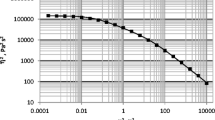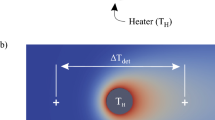Summary
Compared to the similar pressure-distribution cone-and-plate apparatus of Adams and Lodge (4), the new apparatus' improvements include: temperature control of the cone (as well as the plate); increased stiffening of the frame; four (not three) pressuremeasuring holes in the cone/plate region; inclusion of a pressure-measuring hole on the axis under the cone truncation; exclusive use of a vertical free liquid boundary at the cone rim (without a “sea” of liquid). Temperature control of the rotating cone and of the fixed plate leads to acceptable temperature uniformity in the test liquid for working temperatures within 10°C or 20°C of ambient; the corresponding interval is about 1°C if the cone temperature control is abandoned. Pressure gradients measured using a Newtonian liquid agree with those calculated using Walters' eq. (3). For a viscoelastic liquid, after subtracting inertial contributions, pressure distributions measured at a given shear rate in the cone/plate region do not change when the gap angle is changed from 2° to 3°, showing that the effects of secondary flow are negligible. Values ofN 3 =N 1 + 2N 2 obtained from the gradients of these distributions are believed to be in error by not more than ±1 Pa, in favorable cases. The present most useful ranges are: 10 to 5000 Pa forN 3; 0.1 to 200 sec−1 for shear rate; up to 5 Pa s for viscosity; and 5 to 40°C for temperature. As an application, it is shown that adding 0.1% of a high molecular weight polyisobutylene to a 2% polyisobutylene solution doublesN 3 and has no detectable effect on the viscosity measured at low shear rates with a Ferranti-Shirley viscometer.
Zusammenfassung
Im Vergleich zu dem ähnlichen Kegel-Platte-Gerät von Adams und Lodge (4) zur Messung der Druckverteilung wurden an dem neuen Gerät die folgenden Verbesserungen vorgenommen: Temperaturregelung an Kegel und Platte, Versteifung des Rahmens, vier (anstatt drei) Druckmeßlöcher im Kegel-Platte-Bereich, ein zusätzliches Druckmeßloch auf der Achse unter der Kegelstumpf-Deckfläche, ausschließliche Verwendung einer vertikalen freien Grenzfläche der Flüssigkeit am Kegelrand (ohne umgebenden „Flüssigkeitssee“). Die Temperaturregelung des rotierenden Kegels und der festen Platte führt zu einer ausreichenden Temperaturgleichförmigkeit in der Testflüssigkeit für Betriebstemperaturen, die höchstens um 10–20°C von der Umgebungstemperatur abweichen. Dieses Intervall beträgt dagegen nur etwa 1°C, wenn auf die Temperaturregelung am Kegel verzichtet wird. Für newtonsche Flüssigkeiten entsprechen die gemessenen Druckgradienten den mittels der Gleichung von Walters (3) berechneten. Für viskoelastische Flüssigkeiten zeigen sich bei der Änderung des Spaltwinkels von 2° auf 3° nach Abzug der Trägheitsbeiträge keine Änderungen der bei einer bestimmten Schergeschwindigkeit gemessenen Druckverteilung. Dies zeigt, daß Sekundärströmungseffekte vernachlässigbar sind. Es darf angenommen werden, daß die Werte vonN 3 =N 1 + 2N 2, die man aus den Gradienten dieser Verteilungen erhält, unter günstigen Umständen mit einem Fehler von nicht mehr als ±1 Pa behaftet sind. Gegenwärtig liegen die günstigsten Bereiche bei 10 bis 5000 Pa fürN 3, 0,1 bis 200 s−1 für die Schergeschwindigkeit, unterhalb von 5 Pa s für die Viskosität und 5 bis 40°C für die Temperatur. Als Anwendung wird gezeigt, daß ein Zusatz von 0,1% hochmolekularen Polyisobutylens zu einer 2%igen Polyisobutylenlösung den Wert vonN 3 verdoppelt, aber keinen erkennbaren Einfluß auf die (bei geringen Schergeschwindigkeiten mit einem Ferranti-Shirley-Viskosimeter gemessen) Viskosität hat.
Similar content being viewed by others
Abbreviations
- udsf:
-
unidirectional shear flow
- TCP:
-
truncated-cone and plate
- N 1,N 2 :
-
1st and 2nd normal stress differences in udsf
- N 3 :
-
N 1 + 2N 2
- : =:
-
A is defined by the equationA := B
- P * :
-
hole pressurePw − Pm; Pw, Pm = pressures measured by flush transducer and by hole-mounted transducer
- t :
-
time
- κ,\(\dot s\) :
-
strain rate, shear rate
- γ(P,t) :
-
covariant body metric tensor at particleP and timet
- α i,α i :
-
covariant and contravariant udsf body base vectors (i = 1, 2, 3)
- γ −1 :
-
inverse ofγ
- R,α :
-
plate radius, cone/plate gap angle
- r 0,h 0 :
-
radius and height of cone truncation
- r,θ,φ :
-
spherical polar coordinates; cone axisθ = 0; plate surfaceθ = π/2
- :
-
physical components of stress;
for a tensile component
- Ω :
-
cone angular velocity
- p :
-
on the plateθ = π/2
- ρ,T,η :
-
density, absolute temperature, viscosity
- P ρ :
-
0.15ρΩ 2(r 2 −R 2) (inertial contribution) [2.7]
- P ve :
-
contribution [2.8] from flow perturbations of viscoelastic origin
- r i :
-
i = 1,2,3,4; values ofr at centers of holes in cone/plate region
- P i (Ω):
-
pressure change recorded by transducerTi when cone angular velocity goes from zero toΩ
- \(\bar P_i \) :
-
1/2 {P i (Ω)+ P i (−Ω)} (average for 2 senses of rotation)
- \(\bar p\left( R \right)\) :
-
rim pressure, from least-squares line through four points\(\left\{ {\bar P_i - p_\rho , \ln r_i ; i = 1, 2, 3, 4} \right\}\)
- Re :
-
Reynolds' number:ραΩR 2/η
- \(\dot \gamma \left( {P, t} \right)\) :
-
∂γ(P,t)/∂t
References
Lodge, A. S., Body Tensor Fields in Continuum Mechanics, Academic Press (London and New York 1974).
Bird, R. B., R. C. Armstrong, O. Hassager, Dynamics of Polymeric Liquids: Volume I: Fluid Mechanics, John Wiley & Sons (New York 1977).
Walters, K., Rheometry, Chapman and Hall (London 1975).
Adams, N., A. S. Lodge, Phil. Trans.A256 149 (1964).
Hou, T. H., Ph. D. Diss., Department of Engineering Mechanics, University of Wisconsin-Madison (1980). Rheology Research Center Report RRC 59.
Lodge, A. S., Rheol. Acta10 554 (1971).
Lipson, J. M., A. S. Lodge, Rheol. Acta7 364 (1968).
Kaye, A., A. S. Lodge, D. G. Vale, Rheol. Acta7 368 (1968).
Broadbent, J. M., A. S. Lodge, Rheol. Acta10 557 (1971).
Pritchard, W. G., Phil. Trans.A270 507 (1971).
Lodge, A. S., J. Sci. Instrum.37 401 (1960).
Higashitani, K., A. S. Lodge, Trans. Soc. Rheol.19:2, 307 (1975).
Wagner, M. H., Rheol. Acta16 43 (1977).
Abdel-Khalik, S. I., O. Hassager, R. B. Bird, Polymer Engr. Sci.14 859 (1974).
Bird, R. B., O. Hassager, S. I. Abdel-Khalik, Amer. Inst. Chem. Engs. J.20 1041 (1974).
Den Otter, J. L., Dynamic Properties of Some Polymeric Systems, Ph. D. Diss., University of Leiden, The Netherlands (1967).
Tong, P. P., Ph. D. Diss., Materials Science Program, University of Wisconsin-Madison (1980).
Christiansen, E. B., W. R. Leppard, Trans. Soc. Rheol.18 65 (1974).
Higashitani, K., W. G. Pritchard, Trans. Soc. Rheol.16:4 687–696 (1972).
Baird, D. G., Trans. Soc. Rheol.19:1 147–151 (1975).
Vinogradov, G. V., A. Ya. Malkin, Karl Weissenberg 80th Birthday Celebration Essays (E. African Lit. Bureau, Nairobi, Ed. J. Harris) (1973).
Wales, J. L. S. Doctoral Diss. pp. 71, 72. Delft University Press (1976).
Author information
Authors and Affiliations
Additional information
With 11 figures and 2 tables
Rights and permissions
About this article
Cite this article
Lodge, A.S., Hou, T.H. On the measurement of normal stress differences in steady shear flow. Rheol Acta 20, 247–260 (1981). https://doi.org/10.1007/BF01678026
Received:
Issue Date:
DOI: https://doi.org/10.1007/BF01678026




